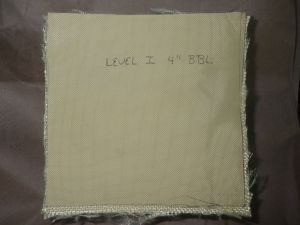In the previous post, an oft-repeated Internet legend regarding .22LR and light body armor was examined. .22LR has a reputation as a very high penetrating round, more so than .45 ACP. In this post, the results of an objective shoot test to determine the validity of that legend are posted.
The outcome was quite informative
As mentioned earlier, four panels (two 7-layer Level I equivalent, and two 12-layer Level IIA equivalent) were constructed. A block of #1 Roma Plastalina modeling clay was used as the backing, both to provide the requisite yielding surface for proper functioning of the armor, and to act as a witness panel for purposes of backface deformation/penetration evaluation.

Round used was the Remington Viper Hypervelocity 36gr. copper-washed truncated cone round, with a listed MV of 1410 FPS (out of a 20″ barrel).
Test platforms were a 4″ barrel and a 16″ barrel.


First up was the 4″ barrel and level I panel. Not surprisingly, the round was stopped by the first layer of material. Backface deformation was 11.65mm (for reference, the NIJ allows soft armor up to 44mm of backface deformation and still pass). Note the unburned powder near the impact.


Next up was the 4″ barrel and level IIA panel. Even less surprising, the round was stopped in the first layer. Backface deformation was 11.23mm. Note the crater was wider than the level I impact, showing that the force was spread over a larger area due to more fibers being involved in the arrest of the round.


Next up was the 16″ barrel and level IIA panel. Out of a 16″ barrel, this round is really moving (at least 1300 fps). The round penetrated four layers of material, and was stopped by the fifth. Backface deformation was 12.55mm.



Finally, the test everyone was waiting for: the level I panel and 16″ barrel. To dispense with the suspense, the round penetrated. It penetrated all 7 layers, with major fragments caught by the 7th. A surprisingly deep cavity was created (most likely due to fragments and expanding muzzle gases) 68mm deep into the clay.
So, thus ends (hopefully) internet rumors surrounding soft armor penetration by .22LR. What can be gleaned from this test: level I armor will stop what it is rated to stop, at least as far as .22LR.
Even though HV rounds were used, out of a 4″ barrel they cannot achieve a full powder burn, and so the velocity does not exceed the 1050 fps limit stipulated by level I. However, level I SHOULD NOT be relied upon to stop .22LR from a barrel longer than approximately 10″ (the point at which the velocity threshold is exceeded). As this test demonstrates, reading the specs for your armor is VERY IMPORTANT.
I do not recommend the use of level I armor, unless there are NO other alternatives. As can be seen, the extra layers of level IIA make a tremendous difference in terms of round-stopping ability. IIA should be considered the absolute MINIMUM for soft armor, and level I be retired as a ballistic rating.









